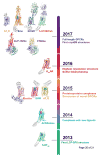Structural biology of G protein-coupled receptors: new opportunities from XFELs and cryoEM
- PMID: 29554543
- PMCID: PMC6139287
- DOI: 10.1016/j.sbi.2018.03.009
Structural biology of G protein-coupled receptors: new opportunities from XFELs and cryoEM
Abstract
G protein-coupled receptors mediate cell signaling and regulate the majority of sensory and physiological processes in the human body. Recent breakthroughs in cryo-electron microscopy and X-ray free electron lasers have accelerated structural studies of difficult-to-crystallize receptors and their signaling complexes, and have opened up new opportunities in understanding conformational dynamics and visualizing the process of receptor activation with unprecedented spatial and temporal resolution. Here, we summarize major milestones and challenges associated with the application of these techniques and outline future directions in their development with a focus on membrane protein structural biology.
Copyright © 2018 Elsevier Ltd. All rights reserved.
Figures



References
-
- Rosenbaum DM, Cherezov V, Hanson MA, Rasmussen SGF, Thian FS, Kobilka TS, Choi H-J, Yao X-J, Weis WI, Stevens RC, et al. GPCR Engineering Yields High-Resolution Structural Insights into β2-Adrenergic Receptor Function. Science. 2007;318:1266–1273. - PubMed
Publication types
MeSH terms
Substances
Grants and funding
LinkOut - more resources
Full Text Sources
Other Literature Sources

